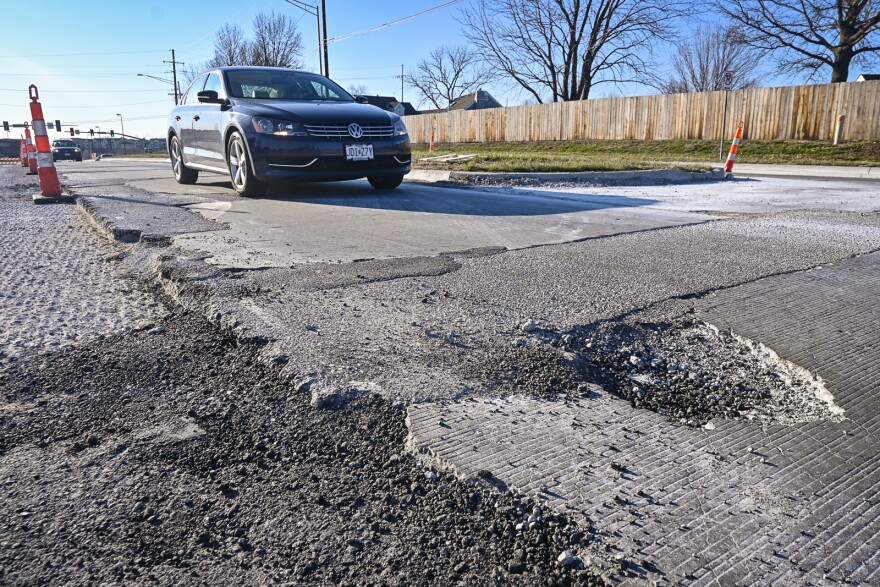The start of spring means that Kansas City drivers are once again facing off with gaping, tire-devouring potholes that litter city streets.
Motorists dodge them when possible, but they can be hard to see — especially at night or when they get filled with rain water — wreaking havoc on car suspensions and even causing crashes.
You can see just how widespread the problem is on Kansas City’s pothole tracker map, which logs reported issues and when they’ve been resolved. Fixing them is a year-round project.
“We do about 50 or 60,000 potholes a year at this point,” says Kansas City Manager Brian Platt. “But ideally that number goes down as we have better road quality and road conditions.”
Potholes develop when moisture seeps below the pavement. When the water freezes, it expands, causing the pavement to bulge and bend. Then when the ice melts, the substrate weakens and finally collapses under the weight of traffic.
Kansas City dispatches pothole crews roads most every day – weather permitting. Platt said they currently have six crews out on the street, and are adding three more to stay ahead of the demand.
But Platt said the city is focusing more on the longer-term fix of resurfacing, which can create smoother streets that are less prone to potholes in the first place.
“If we do notice streets with a lot of potholes and a lot of pothole requests, rather than try to fill all those potholes, absent some safety issue that we need to address very quickly, we'll put that on the list for rapid addressing with street resurfacing,” Platt says.
How the city figures out which streets to fix
Kansas City budgeted $40 million in 2022 for street resurfacing — more than double the previous year. Platt says they hope to add even more funding in 2023.
This week, city crews began the process of resurfacing streets that were previously targeted for repair.
One of the first on the list was 96th Street near N. Oak Trafficway in the Northland. Workers started milling the top layer from the outside lanes, revealing a grooved surface where fresh asphalt will be poured in the coming days.
Traffic can still travel on the inside lanes of the stretch, but still have to avoid the existing potholes before crews can resurface those lanes.
Kansas City uses a graphic imaging system that photographs every street, and uses an algorithm to analyze the depressions and imperfections in the road. Platt said that information gets turned into a rating that city officials use to prioritize which roads get resurfaced the next cycle.

The city also relies on resident feedback. That’s why Platt encourages residents to call the city’s 311 hotline or use the myKCMO app to report any street problems they see.
Residents can see which street projects are next up on the city’s website, which says that 300 miles of lane resurfacing, 150 miles of crack sealing and 145 miles of micro-surfacing are planned for the 2022-23 fiscal year, which ends in April.
Not fast enough
Waldo resident Frank Sereno, Jr. has been an anti-pothole activist for 12 years since he hit one with his motorcycle, narrowly avoiding an accident. He says the city still isn’t doing enough to keep up with deteriorating street conditions.
“The problem here in Kansas City is they've purposely neglected the roads for so long. The streets have now cracked. They've outlived their usefulness,” Sereno said. “Even rain gets into the subgrade and loosens the asphalt. It literally is turning to gravel. It's so outdated and degraded.”
Sereno complained about several roads in the Waldo area along Wornall and Holmes where potholes have proliferated. He says one particular spot, at 82nd and Cherry near his home, has not been repaired since he reported it in October.
Out of frustration with the lack of response from the city, Sereno began a Change.org petition in 2020 to “Repave Waldo.” He’s gathered 3,100 signatures in the three years since it launched. He even set up a sign on a trailer at 75th and Wornall, calling out city hall on the road conditions.
“Even though they're doing a much better job funding it, we're still below the level or the threshold to even try to get ahead,” Sereno says.

Like death and taxes
According to the Missouri Department of Transportation, spring will always bring more potholes — and there’s not much anyone can do about it.
Matt Killion, MoDOT’s assistant district engineer for the Kansas City district, says the temperature fluctuations in the Midwest make the roadways particularly susceptible to pothole formation.
“We had temperatures in the 30s, and then I think tomorrow is supposed to be up in the 60s,” Killion said this week. “So that temperature swing and combined with moisture is kind of a recipe for creating potholes.”
Around Kansas City, sometimes road repairs are the domain of MoDOT rather than the Kansas City government -- including Bannister Road, which is often cited by residents as a problem street.
Like Kansas City, MoDOT has crews working year-round to do patch jobs, and ramp up more when winter ends.
This year is so far proving comparable to past years in pothole repairs, Killion says. MoDOT patched 800,000 potholes statewide on state roadways and interstate highways in 2022.
Platt said the city has resurfaced 600 miles of roadway in the past two years, and they hope to reach 1,000 by the end of the year.
How to report road conditions
Kansas City residents can use the 311 hotline to call in pothole repairs or the myKCMO app available for Android and iPhones.
Missouri motorists can report the location of potholes on state-maintained roads by calling MoDOT’s Customer Service Center at 1-888-ASK-MODOT (275-6636) or using the “Report a Road Concern” form on the website.
In Kansas, people can use the Kansas Department of Transportation online pothole reporting form.






